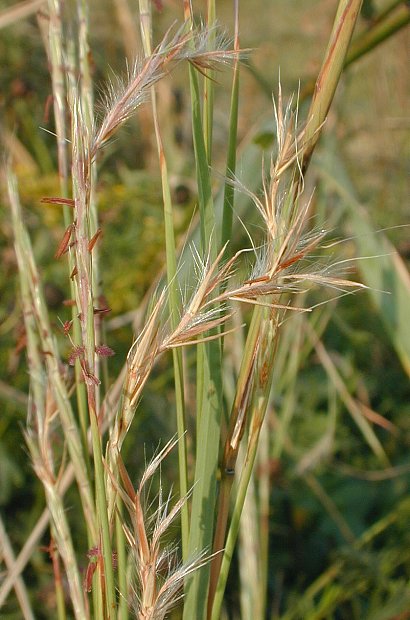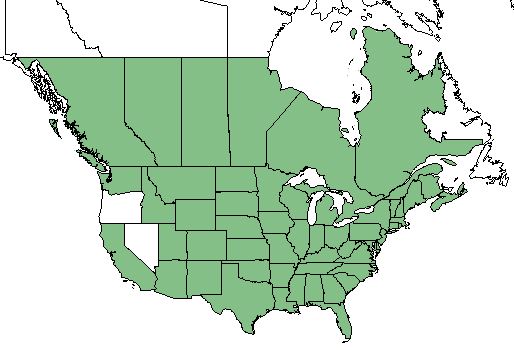Difference between revisions of "Schizachyrium scoparium"
(→Ecology) |
Lsandstrum (talk | contribs) |
||
| Line 32: | Line 32: | ||
==Ecology== | ==Ecology== | ||
===Habitat=== <!--Natural communities, human disturbed habitats, topography, hydrology, soils, light, fire regime requirements for removal of competition, etc.--> | ===Habitat=== <!--Natural communities, human disturbed habitats, topography, hydrology, soils, light, fire regime requirements for removal of competition, etc.--> | ||
| − | ''S. scoparium'' proliferates in various open habitats, in a wide range of moist to dry habitats, fall-line sandhills in the inner Coastal Plain, perhaps in other dry habitats. <ref name= "Weakley 2015"> Weakley, A. S. (2015). Flora of the Southern and Mid-Atlantic States. Chapel Hill, NC, University of North Carolina Herbarium. </ref> It also occurs often in relic ''P. palustris''/wiregrass communities. <ref name= "Andreu 2009"> Andreu, M. G., et al. (2009). "Can managers bank on seed banks when restoring Pinus taeda L. plantations in Southwest Georgia?" Restoration Ecology 17: 586-596. </ref> Specimens have been collected from wet pine flatwoods, palmetto slash pine woodland, oak-palmetto woodland, blaffs along river, treeless chalk glade, wet road ditch, cypress swamp, dry glade, palm hammock, sand-pine oak woodland, slashpine savanna, longleaf pine sand ridge, pine flatwoods, longleaf pine wiregrass savanna, upland old field, pond pine flatwoods, and open river banks.<ref name = "FSU herbarium"> URL: http://herbarium.bio.fsu.edu. Last accessed: June 2018. Collectors: R.K. Godfrey, Angus Gholson, Cecil Slaughter, Loran C. Anderson, Mark A> Garland, Marc Minno, Wilson Baker, Ann F. Johnson, R. Komarek, R. Kral, Richard S. Mitchell, R. E. Perdue, A.F. Clewell, Robert Blaisdell, Robert Lazor, Ginny Vail, Sidney McDaniel. States and counties: Georgia (Grady, Thomas, Baker) Alabama (Crenshaw) Louisiana (Winn) Florida (Grady, Okaloosa, Indian River, Franklin, Gadsden, Clay, Wakulla, Jackson, Volusia, Flagler, Leon, Walton, Bay, Escambia, Liberty, Columbia, Osceola, Marion, Taylor, Madison, Levy, Dixie, Baker, Calhoun, Okaloosa, Santa Rosa, Nassau) </ref> It is considered to be a species that is indicative of non-agricultural history on frequently burned longleaf pine habitat.<ref name= "Hahn"/> | + | ''S. scoparium'' proliferates in various open habitats, in a wide range of moist to dry habitats, fall-line sandhills in the inner Coastal Plain, perhaps in other dry habitats. <ref name= "Weakley 2015"> Weakley, A. S. (2015). Flora of the Southern and Mid-Atlantic States. Chapel Hill, NC, University of North Carolina Herbarium. </ref> It also occurs often in relic ''P. palustris''/wiregrass communities. <ref name= "Andreu 2009"> Andreu, M. G., et al. (2009). "Can managers bank on seed banks when restoring Pinus taeda L. plantations in Southwest Georgia?" Restoration Ecology 17: 586-596. </ref> Specimens have been collected from wet pine flatwoods, palmetto slash pine woodland, oak-palmetto woodland, blaffs along river, treeless chalk glade, wet road ditch, cypress swamp, dry glade, palm hammock, sand-pine oak woodland, slashpine savanna, longleaf pine sand ridge, pine flatwoods, longleaf pine wiregrass savanna, upland old field, pond pine flatwoods, and open river banks.<ref name = "FSU herbarium"> URL: http://herbarium.bio.fsu.edu. Last accessed: June 2018. Collectors: R.K. Godfrey, Angus Gholson, Cecil Slaughter, Loran C. Anderson, Mark A> Garland, Marc Minno, Wilson Baker, Ann F. Johnson, R. Komarek, R. Kral, Richard S. Mitchell, R. E. Perdue, A.F. Clewell, Robert Blaisdell, Robert Lazor, Ginny Vail, Sidney McDaniel. States and counties: Georgia (Grady, Thomas, Baker) Alabama (Crenshaw) Louisiana (Winn) Florida (Grady, Okaloosa, Indian River, Franklin, Gadsden, Clay, Wakulla, Jackson, Volusia, Flagler, Leon, Walton, Bay, Escambia, Liberty, Columbia, Osceola, Marion, Taylor, Madison, Levy, Dixie, Baker, Calhoun, Okaloosa, Santa Rosa, Nassau) </ref> It is considered to be a species that is indicative of non-agricultural history on frequently burned longleaf pine habitat.<ref name= "Hahn"/> ''S. scoparium'' responds negatively to soil disturbance by agriculture in Southwest Georgia.<ref>Hedman, C.W., S.L. Grace, and S.E. King. (2000). Vegetation composition and structure of southern coastal plain pine forests: an ecological comparison. Forest Ecology and Management 134:233-247.</ref> |
===Phenology=== <!--Timing off flowering, fruiting, seed dispersal, and environmental triggers. Cite PanFlora website if appropriate: http://www.gilnelson.com/PanFlora/ --> | ===Phenology=== <!--Timing off flowering, fruiting, seed dispersal, and environmental triggers. Cite PanFlora website if appropriate: http://www.gilnelson.com/PanFlora/ --> | ||
Revision as of 20:12, 12 July 2019
Common name: pinehill bluestem [1], common little bluestem [1], creeping little bluestem [1], little bluestem [2]
| Schizachyrium scoparium | |
|---|---|

| |
| Photo by John Hilty hosted at IllinoisWildflowers.info | |
| Scientific classification | |
| Kingdom: | Plantae |
| Division: | Magnoliophyta - Flowering plants |
| Class: | Liliopsida - Moncots |
| Order: | Poales |
| Family: | Poaceae |
| Genus: | Schizachyrium |
| Species: | S. scoparium |
| Binomial name | |
| Schizachyrium scoparium (Michx.) Nash | |

| |
| Natural range of Schizachyrium scoparium from USDA NRCS Plants Database. | |
Contents
Taxonomic Notes
Synonyms: (for var. divergens) Andropogon scoparius Michaux var. divergens Hackel; Andropogon divergens; (for var. scoparium) S. scoparium; S. scoparium ssp. scoparium; (for var. stoloniferum) S. stoloniferum Nash; Andropogon stolonifer (Nash) A.S. Hitchcock
Varieties: Schizachyrium scoparium (Michaux) Nash var. divergens (Hackel) Gould; Schizachyrium scoparium (Michaux) Nash var. scoparium; Schizachyrium scoparium (Michaux) Nash var. stoloniferum (Nash) J. Wipff
Description
S. scoparium is a perennial graminoid of the Poaceae family native to North America and Canada and introduced to Hawaii. [2]
Distribution
S. scoparium is found: everywhere in the United States excluding Oregon and Nevada; every region in Canada; every island in Hawaii. [2]
Ecology
Habitat
S. scoparium proliferates in various open habitats, in a wide range of moist to dry habitats, fall-line sandhills in the inner Coastal Plain, perhaps in other dry habitats. [1] It also occurs often in relic P. palustris/wiregrass communities. [3] Specimens have been collected from wet pine flatwoods, palmetto slash pine woodland, oak-palmetto woodland, blaffs along river, treeless chalk glade, wet road ditch, cypress swamp, dry glade, palm hammock, sand-pine oak woodland, slashpine savanna, longleaf pine sand ridge, pine flatwoods, longleaf pine wiregrass savanna, upland old field, pond pine flatwoods, and open river banks.[4] It is considered to be a species that is indicative of non-agricultural history on frequently burned longleaf pine habitat.[5] S. scoparium responds negatively to soil disturbance by agriculture in Southwest Georgia.[6]
Phenology
S. scoparium has been observed to flower in November. [7]
Fire ecology
S. scoparium is highly fire tolerant, resprouting quickly following fire, and is the dominant grass species in some fire-dependent communities (e.g., western upland longleaf pine forest).[8] A study found overall herbivory to decrease with higher fire return interval regiments.[5]
Use by animals
S. scoparium has medium palatability for browsing animals and high palatability for grazing animals. [2] It is sometimes foraged by common grasshoppers in the subfamilies Melanoplinae and Cyrtacanthacridinae, which are known as mixed feeders.[5]
Conservation and Management
Cultivation and restoration
Photo Gallery
References and notes
- ↑ 1.0 1.1 1.2 1.3 Weakley, A. S. (2015). Flora of the Southern and Mid-Atlantic States. Chapel Hill, NC, University of North Carolina Herbarium.
- ↑ 2.0 2.1 2.2 2.3 USDA Plant Database https://plants.usda.gov/core/profile?symbol=SCSC
- ↑ Andreu, M. G., et al. (2009). "Can managers bank on seed banks when restoring Pinus taeda L. plantations in Southwest Georgia?" Restoration Ecology 17: 586-596.
- ↑ URL: http://herbarium.bio.fsu.edu. Last accessed: June 2018. Collectors: R.K. Godfrey, Angus Gholson, Cecil Slaughter, Loran C. Anderson, Mark A> Garland, Marc Minno, Wilson Baker, Ann F. Johnson, R. Komarek, R. Kral, Richard S. Mitchell, R. E. Perdue, A.F. Clewell, Robert Blaisdell, Robert Lazor, Ginny Vail, Sidney McDaniel. States and counties: Georgia (Grady, Thomas, Baker) Alabama (Crenshaw) Louisiana (Winn) Florida (Grady, Okaloosa, Indian River, Franklin, Gadsden, Clay, Wakulla, Jackson, Volusia, Flagler, Leon, Walton, Bay, Escambia, Liberty, Columbia, Osceola, Marion, Taylor, Madison, Levy, Dixie, Baker, Calhoun, Okaloosa, Santa Rosa, Nassau)
- ↑ 5.0 5.1 5.2 Hahn, P. C. and J. L. Orrock (2015). "Land-use legacies and present fire regimes interact to mediate herbivory by altering the neighboring plant community." Oikos 124: 497-506.
- ↑ Hedman, C.W., S.L. Grace, and S.E. King. (2000). Vegetation composition and structure of southern coastal plain pine forests: an ecological comparison. Forest Ecology and Management 134:233-247.
- ↑ Nelson, G. PanFlora: Plant data for the eastern United States with emphasis on the Southeastern Coastal Plains, Florida, and the Florida Panhandle. www.gilnelson.com/PanFlora/ Accessed: 29 MAY 2018
- ↑ Smith, L. 2009. The natural communities of Louisiana. Louisiana Natural Heritage Program, Louisiana Department of Wildlife and Fisheries, 46 pp.